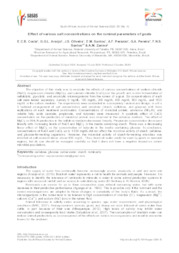Effect of various salt concentrations on the ruminal parameters of goats.
Effect of various salt concentrations on the ruminal parameters of goats.
Author(s): COSTA, E. C. B.; ARAUJO, G. G. L. de; OLIVEIRA, J. S.; SANTOS, E. M.; PEREIRA, A. F. P. G. A.; SANTOS, F. N. S.; ZANINE, A. M.
Summary: The objective of this study was to evaluate the effects of various concentrations of sodium chloride (NaCl), magnesium chloride (MgCl2), and calcium chloride (CaCl2) on the growth and in vitro fermentation of cellulolytic, glycolytic, and amylolytic microorganisms from the rumen of a goat. Six concentrations of each salt were tested separately, namely 0 mg/dL, 100 mg/dL, 200 mg/dL, 400 mg/dL, 800 mg/dL, and 1600 mg/dL in the culture medium. The experiments were conducted in a completely randomized design, in a 6 x 3 factorial arrangement of salt concentration and substrate (starch, cellulose, and glucose) with three replications of each treatment combination. Concentrations of microbial protein, ammonia (NH3-N), and volatile fatty acids (acetate, propionate, and butyrate) were measured. A quadratic effect of CaCl2 concentration on the production of microbial protein was observed in the cellulose medium. The effect of MgCl2 on NH3-N production in the cellulose medium decreased linearly. Propionate concentration decreased linearly with increasing levels of NaCl and MgCl2 in the media containing starch. There was a decreasing linear effect of MgCl2 on the concentration of butyrate in the media containing glucose. In conclusion, concentrations of NaCl and CaCl2 up to 1,600 mg/dL did not affect the microbial activity of starch, cellulose, and glucose-fermenting organisms. However, the microbial activity of starch-fermenting microbes was inhibited at salt concentrations above 800 mg/dL. Thus, brackish water could be used by goats in semiarid regions, but its use should be managed carefully so that it does not have a negative impact on rumen microbial populations.
Publication year: 2020
Types of publication: Journal article
Unit: Embrapa Semi-arid Region
Observation
Some of Embrapa's publications are published as ePub files. To read them, use or download one of the following free software options to your computer or mobile device. Android: Google Play Books; IOS: iBooks; Windows and Linux: Calibre.
Access other publications
Access the Agricultural Research Database (BDPA) to consult Embrapa's full library collection and records.
Visit Embrapa Bookstore to purchase books and other publications sold by Embrapa.

